Articles
Evaluation of temporo-mandibular disorders and tinnitus through DC/TMD and the THI questionnaire
OBJECTIVES: Tinnitus is a common and annoying disorder that results in a perceived sound or noise without an external origin. Tinnitus patients frequently experience anxiety, depression, insomnia and a poor quality of life. Some articles, have demonstrated that TMJ-related muscle issues can result in somatosensory tinnitus.
This study’s objectives are to assess the prevalence of tinnitus in patients with temporo-mandibular disorders (TMD) and to compare the results of TMD treatment in patients with tinnitus to those in a control group who do not have tinnitus.
MATERIALS AND METHODS: The study approved by the Ethical Committe of the University of Campania Luigi Vanvitelli (reference number: 0032351/I) will include subjects with signs and symptoms of temporomandibular disorders.
The patients will be treated for about 6 months with TENS performed by an appliance called Tens Myotronic s-Model BNS-40 muscle stimulator (about 30 min every 2/3 weeks), a hard flat acrylic splint, counseling and a behavioral psychologic therapy, as needed.
Behavioral psychologic therapy consists of self-inspection to avoid parafunction, self-care instructions, individual physiotherapeutic treatments, including passive muscle stretching, massaging of the affected masticatory elevator muscles, relaxation exercises, mouth-opening exercises.
Diagnostic data before and after treatment will be obtained following the Axis I and II of the Diagnostic Criteria for Temporo-Mandibular Disorders (DC/TMD) and the Tinnitus Handicap Inventory (THI) questionnaire.
Each evaluation carried out for TMD/tinnitus diagnosis will be repeated before and after treatment to compare the symptoms in each patient.
Data analysis will be performed by a statistician and descriptive assessments will include calculation of the mean and standard deviation. Statistical significance will be set at P <0.05. It will be considered necessary to recruit about 20 patients for each group based on previous similar studies.
RESULTS: The outcomes will give an update on the prevalence of tinnitus in patients with TMD.
CONCLUSIONS: Then, our data will integrate the lack of knowledge on the possible positive effects of a conventional TMD treatment on TMD with possible reduction/disappearance of tinnitus, when present, following the internationally recognized diagnostic criteria (DC/TMD).
CLINICAL SIGNIFICANCE: Tinnitus is one of the symptoms of TMD.
Per continuare la lettura gli abbonati possono scaricare l’allegato.






